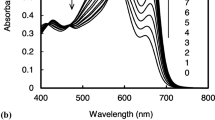Abstract
A fluorimetric method based on fluorescence enhancement effect was developed for the determination of adenosine 5′-monophosphate (AMP) with 9-anthracene carboxylic acid (9-ANCA)–cetyl trimethyl ammonium bromide (CTAB) system. Fluorescence intensity of 9-ANCA was decreased by the addition of CTAB but addition of AMP again rose the intensity of 9-ANCA gradually. The observed fluorescence enhancement is attributed to the competitive binding reaction of 9-ANCA and adenosine to CTAB. The enhancement in the fluorescence intensity was found proportional to the concentration of AMP over the range 2.0 × 10−4 to 1.2 × 10−3 mol dm−3. The ion pair complex is formed spontaneously between 9-ANCA and CTAB. Since the binding interaction is larger for the adenosine–CTAB pair, the fluorophore 9-ANCA will be released. The quantum yield of free 9-ANCA is higher therefore its fluorescence observed at 417 nm wavelength is enhanced. This mechanism of competitive molecular interaction is further confirmed by conductometric measurements. The method was applied successfully for the determination of AMP from pharmaceutical sample. The method is more selective, sensitive and relatively free from interferences.








Similar content being viewed by others
References
Adam W, Arnold MA, Saha-Moller CR (2001) Photo oxidative damage of guanine in DG and DNA by the radicals derived from the cleavage of the electronically excited carbonyl products generated in the thermolysis of alkoxymethyl-substituted dioxetanes and the photolysis of alkoxyacetones. J Org Chem 66:597–604
Hashimoto S (1993) Mechanism of fluorescence quenching of pyrene with purines in polar media formation of the pyrene triplet state via exciplex formation. Phys Chem 97:3662–3667
Claus A, Seidal M (1996) Nucleobase -specific quenching of fluorescent dyes. 1. Nucleobase one-electron redox potentials and their correlation with static and dynamic quenching efficiencies. J Phys Chem 100:5541–5553
Dias RS, Pais AA, Miguel MG, Lindman B (2004) DNA and surfactants in bulk and at interfaces. Colloids Surf A 250:115–131
Kittler L, Lober G, Gollmick FA, Berg H (1980) Redox processes during photodynamic damage of DNA: III redox mechanism of photosensitization and radical reaction. Bioelectrochem Bioenergy 7:503
Cuomo F, Palazzo G, Ceglie A, Lopez F (2009) Quenching efficiency of pyrene fluorescence by nucleotide monophosphates in cationic micelles. J Photochem Photobiol A Chem 202:21
Cuomo F, Lopez F, Angelico R, Colafemmina G, Ceglie A (2008) Nucleotides and nucleolipids derivatives interaction effects during multi-lamellar vesicles formation. Colloid Surf B 64:184
Schmidtchen FP, Berger M (1997) Artificial organic host molecules for anions. Chem Rev 97:1609–1643
Lakowicz JR (1992) Fluorescence spectroscopy, biochemical applications, 3rd edn. Plenum, New York, p 137
Lopez F, Cuomo F, Ceglie A, Ambrosone L, Palazzo G (2008) Quenching and dequenching of pyrene fluorescence by nucleotide monophosphates in cationic micelles. J Phys Chem 112:7338–7344
Foglesong PD (1989) Fluorimetric methods employing low concentrations of ethidium bromide for DNA topoisomerase and endonuclease assays. Anal Biochem 182:284
Akbay N, Seferoglu Z, Gok E (2009) Fluorescence interaction and determination of calf thymus DNA with two ethidium derivatives. J Fluoresc 19:1045–1051
Kapuscinski J, Skoczylas B (1977) Simple and rapid fluorimetric method for DNA microassay. Anal Biochem 83:252
Downs TR, Wilfinger WW (1983) Quantitative determination of a DNA polymerase and a test kit useful in same. Anal Biochem 131:538
Juskowiak B, Grzybowskau I, Takenaka S (2004) Enhanced fluorescence of the Eu3+–naphthalenediimide derivative–phenanthroline ternary complex and the determination of DNA. Anal Chim Acta 512:133–139
Marquez C, Pischel U, Nau WM (2003) Selective fluorescence quenching of 2, 3-diazabicyclo [2.2.2] oct-ene by nucleotides. Org Lett 5:3911–3914
Wenska G, Paszyc S (1988) Ground and excited state interactions of coumarin and nucleotide base. Can J Chem 66:513–516
Krishnamurthy NV, Reddy AR, Bhudevi B (2008) Wavelength dependant quenching of 2, 5-diphenyloxazole fluorescence by nucleotides. J Fluoresc 18:29–34
Liu J, Wang X, Wang L (2006) Spectrofluorimetric assay of cationic surfactants by fluorescence quenching of 9-anthracenecarboxylic acid. Spectrochimica Acta Part A 63:32–35
Liu J, Wang X, Wang L (2005) A novel spectrofluorimetric method for the determination of DNA. Microchim Acta 151:123–126
Azad HA, EI-korashy SA, Anwar ZM, Hussein BH, Khairy GM (2010) Synthesis and fluorescence properties of Eu-anthracene-carboxylic acid towards N-acetylamino acids and nucleitides in different solvents. Spectrochimica Acta Part A 75:21–27
Huang CZ (1997) Spectrophotometry of nucleic acids by their effect on the complex of cobalt(II) with 4-[(5-chloro-2-pyridyl)azo]-1,3-diaminobenzene. Anal Chim Acta 345:235
Chen H, Zhou M, Jin X, Song Y, Zhong Z, Ma Y (2003) Chemiluminescence determination of ultramicro DNA with a flow-injection method. Anal Chim Acta 478:31
Ma YJ, Zhou M, Jin XY, Zhang ZY (2004) Flow-injection chemiluminescence assay for ultra-trace determination of DNA using rhodamine B–Ce (IV)-DNA ternary system in sulfuric acid media. Anal Chim Acta 501:25
Pang DW, Abruna HD (1998) Micromethod for the Investigation of the Interactions between DNA and redox-active molecules. Anal Chem 70:3162
Fu C, Song L, Fang Y (1999) Determination of adenosine phosphate by co-electroosmotic capillary electrophoresis with amperometric detection. Anal Chim Acta 399:259–263
Yu F, Li L, Chen F (2008) Determination of adenosine disodium triphosphate using prulifloxacin–terbium(III) as a fluorescence probe by spectrofluorimetry. Anal Chim Acta 610:25
Khot MS, Bhattar SL, Kolekar GB, Patil SR (2010) Spectrofluorimetric determination of 5-fluorouracil by fluorescence quenching of 9-anthracenecarboxtlic acid. Spectrochimica Acta Part A 77:82–86
Shah SS, Naeem K, Shah SW, Laghari GM (2000) Differential absorbance measurements of amphiphilic hemicyanine dyes, solubilization study in anionic surfactant. Colloids Surf A 168:77
Bhattar SL, Kolekar GB, Patil SR (2008) Fluorescence resonance energy transfer between perylene and riboflavin in micellar solution and analytical application on determination of vitamin B2. J Luminescence 128:306–310
Acknowledgement
The authors gratefully acknowledge, Department of Science and Technology (DST) and University Grants Commission (UGC) New Delhi for providing grants to the Department of Chemistry, Shivaji University, Kolhapur under FIST and SAP program, respectively.
Author information
Authors and Affiliations
Corresponding author
Rights and permissions
About this article
Cite this article
Khot, M.S., Desai, N.K., Kolekar, G.B. et al. Fluorescence Enhancement Effect for the Determination of Adenosine 5′-Monophosphate with 9-Anthracene Carboxylic Acid-Cetyl Trimethyl Ammonium Bromide System. J Fluoresc 21, 1997–2003 (2011). https://doi.org/10.1007/s10895-011-0900-9
Received:
Accepted:
Published:
Issue Date:
DOI: https://doi.org/10.1007/s10895-011-0900-9




